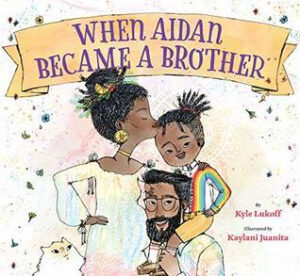This post was written by NCTE member Tadayuki Suzuki, a member of the NCTE LGBTQ Advisory Committee.
In her recommendaiton of LGBTQ books everyone should read, Sally Kaplan notes that LGBTQ books play an important role for validating children’s lives and help them connect with people who are not familiar with the LGBTQ issues.
As part of the recent publishing trends for LGBTQ books, more allies and advocates are standing up and writing these books in order to support and honor the lives of LGBTQ people. Ashley Lauren Sullivan and Laurie Lynne Urraro report that very few picture books about transgender and gender-nonconforming characters are available, and that existing narratives focus on white characters.They further maintain that more books about male-to-female characters than female-to-male characters exist among the books about transgender and gender-nonconforming characters. Fortunately, last year’s When Aiden Became A Brother offers a narrative that is often neglected in children’s books.
 Written by Kyle Lukeoff and illustrated by Kaylani Juanita, When Aidan Became A Brother, is a story about a transgender child. The titular character’s parents tell him that they will welcome a new baby to their family soon. One day, Aidan’s neighbor asks his mother whether she is having a boy or a girl. This question makes Aidan uncomfortable due to his gender nonconformity. When he goes to the hardware store with his father, Aidan tells the paint clerk that he will become a big brother. However, this statement confuses this store clerk since Aidan is misgendered in the clerk’s eyes. Aiden obviously struggles handling with his new appearance in the story. Just before the baby arrives, he begins to wonder if as the big brother, he has done right for the baby who is joining their family soon. Then, his mother tells Aidan that he has taught his family how important it is to love someone for exactly who they are, and this baby is lucky to have him as a big brother.
Written by Kyle Lukeoff and illustrated by Kaylani Juanita, When Aidan Became A Brother, is a story about a transgender child. The titular character’s parents tell him that they will welcome a new baby to their family soon. One day, Aidan’s neighbor asks his mother whether she is having a boy or a girl. This question makes Aidan uncomfortable due to his gender nonconformity. When he goes to the hardware store with his father, Aidan tells the paint clerk that he will become a big brother. However, this statement confuses this store clerk since Aidan is misgendered in the clerk’s eyes. Aiden obviously struggles handling with his new appearance in the story. Just before the baby arrives, he begins to wonder if as the big brother, he has done right for the baby who is joining their family soon. Then, his mother tells Aidan that he has taught his family how important it is to love someone for exactly who they are, and this baby is lucky to have him as a big brother.
As children’s books often portray children’s lives and their families, more books about transgender and gender-nonconforming characters of color need to be written and published in the future to encourage children to express their gender identities more flexibly. For that reason, picture books such as When Aidan Became A Brother become important resources for elementary school teachers. Teachers and librarians may worry about lacking the language to discuss gender-binary and transgender identities with their students when they read certain stories. Fortunately, the Teaching Tolerance Anti-Bias Framework–A Road Map for Anti-bias Education at Every Grade Level offers grade-level appropriate standards and scenarios for teaching diversity and inclusion in the K–12 classrooms and can be a valuable curricular tool.
Teachers can analyze with their students sections of the book such as the part where one character, Joe, notices that Stephen has chosen to play with a baby doll at recess. Joe snatches the doll away from Stephen, saying, “Dolls are for girls, not boys” (p. 3). Teachers can discuss with their students how we should react, how we should express our feelings logically, and what kinds of words are more appropriate to use. In this way, teachers can help their students challenge the gender-binary thinking and attend to Aidan’s situations and his feelings.
It is often hard for children at early elementary levels to engage in sensitive discussions without being equipped with appropriate language. As the learning outcomes in the framework are divided into four domains such as identity, diversity, justice, and action, however, teachers and librarians can pick grade-level appropriate language related to diversity and inclusion, which also helps when they attempt to build their students’ background knowledge of the topic of the story being read. It is also possible for them to modify and adjust these standards and scenarios based on the instructional topics, contexts, and their students’ academic needs.
As educators we know the purpose of utilizing a book like When Aidan Becomes a Brother in the elementary classrooms is to provide children with what Dr. Rudine Sims Bishop calls “mirrors, windows, and sliding doors” into LGBTQ children’s lives, experiences, and dignity.

Tadayuki Suzuki is an associate professor of literacy education at SUNY Cortland, where he teaches both undergraduate and graduate literacy courses. The areas of his academic interest include culturally responsive teaching, children’s literature in literacy instruction, and teaching ESL. He can be reached at tadayuki.suzuki@cortland.edu.
It is the policy of NCTE in all publications, including the Literacy & NCTE blog, to provide a forum for the open discussion of ideas concerning the content and the teaching of English and the language arts. Publicity accorded to any particular point of view does not imply endorsement by the Executive Committee, the Board of Directors, the staff, or the membership at large, except in announcements of policy, where such endorsement is clearly specified.

